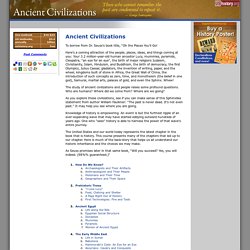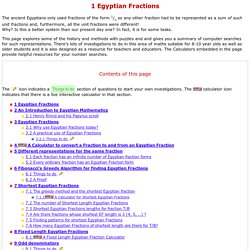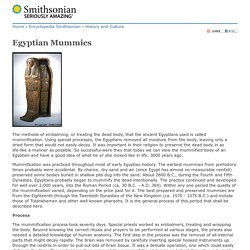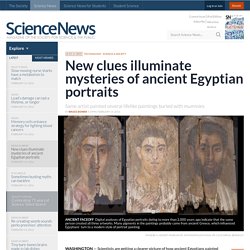

Ancient Civilizations. To borrow from Dr.

Seuss's book title, "Oh the Places You'll Go! Here's a coming attraction of the people, places, ideas, and things coming at you: Your 3.2 million-year-old human ancestor Lucy, mummies, pyramids, Cleopatra, "an eye for an eye", the birth of major religions Judaism, Christianity, Islam, Hinduism, and Buddhism, the birth of democracy, the first Olympics, Julius Caesar, gladiators, the invention of writing, paper, and the wheel, kingdoms built of stone in Africa, the Great Wall of China, the introduction of such concepts as zero, time, and monotheism (the belief in one god), Samurai, martial arts, palaces of gold, and even the Sphinx.
Whew! The study of ancient civilizations and people raises some profound questions. Who are humans? As you explore these civilizations, see if you can make sense of this Sphinxlike statement from author William Faulkner: "The past is never dead. Knowledge of history is empowering. As Seuss promises later in that same book, "Will you succeed? Ancient Civilizations. Sweet Search.
Egyptian Art. History - Ancient History in depth: Sacred Animals of Ancient Egypt Gallery. The Afterlife in Ancient Egypt. Share Posted 01.03.06 NOVA Unlike most scholars of the ancient world, Salima Ikram knows her subjects on an intimate, face-to-face basis.

In this interview, Ikram, an Egyptologist at the American University in Cairo, sheds light on why mummification was practiced in ancient Egypt, what the ancients thought the afterlife would be like, and why—of some 70 million mummies made—very few remain intact today. Like most ancient Egyptians, this wife of a pharaoh died young. But her body was prepared for a glorious afterlife. The allure of mummies NOVA: Why do you think people are so fascinated by mummies? Salima Ikram: Part of it is, of course, all that horror movie business. What's the allure of mummies for Egyptologists? Well, I think one reason is very basic: here we are, studying Tuthmosis III, reading his words on temple walls, and you can actually look at him! Rameses V reigned for only five years during the 20th Dynasty (c. 1196-1070 B.C.).
No. What did they think the afterlife would be like? Daily Life in Ancient Egypt. The daily life in ancient Egypt was actually much different than the vision that commonly comes to mind.

Relics found in archaeological digs as well as paintings and drawings on pyramid and tomb walls depict images of life in ancient Egypt that was, in some regards, not that much different than life in Egypt today. Family Life Family was important in ancient Egypt, and family life began early for the ancient Egyptians. Men and women both tended to marry young, and most marriages were polygamous with the husband having several wives.
The husband usually had a senior or chief wife who was considered higher than the other ones. Children. Discover Ancient Egypt. Egyptian Fractions. 1 Egyptian Fractions The ancient Egyptians only used fractions of the form 1/n so any other fraction had to be represented as a sum of such unit fractions and, furthermore, all the unit fractions were different!

Why? Is this a better system than our present day one? In fact, it is for some tasks. This page explores some of the history and methods with puzzles and and gives you a summary of computer searches for such representations. This page has an auto-generated Content section which may take a second or two to appear. The calculators on this page also require JavaScript but you appear to have switched JavaScript off (it is disabled). 2 An Introduction to Egyptian Mathematics Some of the oldest writing in the world is on a form of paper made from papyrus reeds that grew all along the Nile river in Egypt.
[The image is a link to David Joyce's site on the History of Maths at Clarke University.] So what was on them do you think? 2.1 Henry Rhind and his Papyrus scroll So what did it say? So. The Great Pyramid of Giza. Pyramids of Giza, soaring above the city of Cairo, Egypt The Great Pyramid of Giza is the most substantial ancient structure in the world - and the most mysterious.

According to prevailing archaeological theory - and there is absolutely no evidence to confirm this idea - the three pyramids on the Giza plateau are funerary structures of three kings of the fourth dynasty (2575 to 2465 BC). The Great Sphinx Video - Ancient Egypt. Egyptian Mummies. The methods of embalming, or treating the dead body, that the ancient Egyptians used is called mummification.

Using special processes, the Egyptians removed all moisture from the body, leaving only a dried form that would not easily decay. It was important in their religion to preserve the dead body in as life-like a manner as possible. So successful were they that today we can view the mummified body of an Egyptian and have a good idea of what he or she looked like in life, 3000 years ago. Mummification was practiced throughout most of early Egyptian history. The earliest mummies from prehistoric times probably were accidental. Process The mummification process took seventy days. Mummification. Ancient Egypt - Menu page.
New clues illuminate mysteries of ancient Egyptian portraits. WASHINGTON — Scientists are getting a clearer picture of how ancient Egyptians painted lifelike portraits that were buried with mummies of the depicted individuals.

History: Egyptians. History - Ancient History in depth: The Story of the Nile. Home of The Virtual Egyptian Museum - King Padibastet's Tomb. King Tut Revealed. By A.R.

Williams He was just a teenager when he died. The last heir of a powerful family that had ruled Egypt and its empire for centuries, he was laid to rest laden with gold and eventually forgotten. Since the discovery of his tomb in 1922, the modern world has speculated about what happened to him, with murder the most extreme possibility. Now, leaving his tomb for the first time in almost 80 years, Tut has undergone a CT scan that offers new clues about his life and death—and provides precise data for an accurate forensic reconstruction of the boyish pharaoh. Inside King Tut’s subterranean burial chamber, against a backdrop of sacred murals, Zahi Hawass, head of Egypt’s Supreme Council of Antiquities, removes padding to reveal the young pharaoh’s remains. Clues From Top ... Did the young pharaoh die from a blow to the head? As evidence, they cite an x-ray taken in 1968, which shows a fragment of bone in the skull cavity—emptied by embalmers, according to custom. ... to Bottom.
Explore Ancient Egypt. Ancient History Encyclopedia. Ancient Egypt - Ancient History. Under Ahmose I, the first king of the 18th dynasty, Egypt was once again reunited.

During the 18th dynasty, Egypt restored its control over Nubia and began military campaigns in Palestine, clashing with other powers in the area such as the Mitannians and the Hittites. The country went on to establish the world’s first great empire, stretching from Nubia to the Euphrates River in Asia. In addition to powerful kings such as Amenhotep I (1546-1526 B.C.), Thutmose I (1525-1512 B.C.) and Amenhotep III (1417-1379 B.C.), the New Kingdom was notable for the role of royal women such as Queen Hatshepsut (1503-1482 B.C.), who began ruling as a regent for her young stepson (he later became Thutmose III, Egypt’s greatest military hero), but rose to wield all the powers of a pharaoh.
Carnegie Museum of Natural History: Life in Ancient Egypt. Life in Ancient Egypt Welcome to Life in Ancient Egypt, a companion online exhibition to Walton Hall of Ancient Egypt at Carnegie Museum of Natural History.

Carnegie Museum of Natural History has acquired Egyptian artifacts since its founding and now holds about twenty-five-hundred ancient Egyptian artifacts. NOVA Online/Pyramids/Explore the Pyramids. Discovering Ancient Egypt.